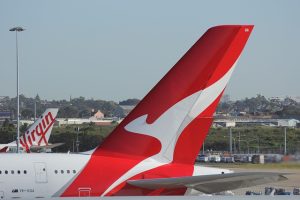
Stabilizers are an essential part of all airplanes. Nearly all airplanes have horizontal stabilizers and vertical stabilizers. They are used to provide stability and control during flight. Even if you’ve seen them when waiting at an airport, though, you might not know how stabilizers work.
Overview of Stabilizers
Stabilizers are fixed or adjustable aerodynamic surfaces on an airplane. Located at the tail of the airplane, they are available in two primary types: horizontal stabilizers and vertical stabilizers.
They are known as “stabilizers” because they provide stability. Whether horizontal or vertical, all stabilizers help to stabilize the airplanes with which they are used. Airplanes are exposed to fast-moving winds during flight, which can affect their maneuverability. Fortunately, they feature aerodynamic surfaces like stabilizers to provide control and stability. Stabilizers will stabilize the airplane during flight so that pilots can safely and effectively maneuver it.
How Stabilizers Work
Vertical stabilizers work by generating a lateral or side force. They are mounted vertically on the rear of an airplane’s tail. Vertical stabilizers consist of a fixed aerodynamic surface as well as one or more adjustable aerodynamic surfaces. The adjustable, albeit still vertical, aerodynamic surfaces are known as rudders.
Pilots can control the airplane’s rudders from the cockpit. Deflecting the airplane’s rudders will change the airplane’s angle of attack. Rudders can be deflected to either the left or right, which will result in a new angle of attack.
Horizontal stabilizers work by generating a downward force. This downward force will counter the upward force produced by the winds encountered by the airplane.
Horizontal stabilizers are mounted horizontally on the rear of an airplane’s tail. Like with vertical stabilizers, they consist of a fixed aerodynamic surface as well as one or more adjustable aerodynamic surfaces. The adjustable aerodynamic surfaces are known as elevators.
Elevators can be deflected up or down. When controlling the airplane’s elevators, pilots will change the airplane’s angle of attack. In turn, this will change the airplane’s pitch attitude.
Adjustable stabilizers, such as rudders and elevators, are controlled using wheels, sticks or pedals. Pilots can manually adjust the deflection of these stabilizers. Doing so will control the airplane’s pitch and yaw attitudes. With that said, some airplanes now feature an automated flight control system, such as a fly-by-wire system, that handles the airplane’s rudders and elevators automatically.
In Conclusion
Airplanes feature a variety of aerodynamic surfaces. In addition to wings, they feature vertical stabilizers and horizontal stabilizers.



